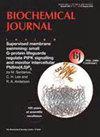And… cut! - how conformational regulation of CRISPR-Cas effectors directs nuclease activity.
IF 4.3
3区 生物学
Q2 BIOCHEMISTRY & MOLECULAR BIOLOGY
引用次数: 0
Abstract
Controlling the conformation of dynamic protein, RNA and DNA molecules underpins many biological processes, from the activation of enzymes and induction of signalling cascades to cellular replication. Clustered regularly interspaced short palindromic repeats (CRISPR)-associated (Cas) effectors are enzymes tightly controlled by conformational steps that gate activation of nuclease domains core to their function in bacterial adaptive immunity. These precise conformational checkpoints combined with programmable activation specified by RNA guides have driven the success of CRISPR-Cas tools in biotechnology, medicine and beyond. To illustrate the importance of conformation in controlling CRISPR-Cas activity, we review the discrete conformational checkpoints at play in class 2 CRISPR-Cas systems. Using Cas9, Cas12a and Cas13a as examples, we describe how protein and nucleic acid conformations precisely control the loading of guide RNA, the selection of target nucleic acids and the activation of nuclease domains. Much like a director controls the timing of transitions between scenes in a movie, CRISPR effectors use conformational checkpoints to precisely direct their enzymatic activity.和……切!- CRISPR-Cas效应物的构象调控如何指导核酸酶活性。
控制动态蛋白质、RNA和DNA分子的构象是许多生物过程的基础,从酶的激活和信号级联的诱导到细胞复制。聚集规律间隔短回文重复(CRISPR)相关(Cas)效应物是由构象步骤严格控制的酶,这些构象步骤对核酸酶结构域的激活至关重要,是它们在细菌适应性免疫中的功能。这些精确的构象检查点与RNA向导指定的可编程激活相结合,推动了CRISPR-Cas工具在生物技术、医学等领域的成功。为了说明构象在控制CRISPR-Cas活性中的重要性,我们回顾了在2类CRISPR-Cas系统中起作用的离散构象检查点。以Cas9、Cas12a和Cas13a为例,我们描述了蛋白质和核酸构象如何精确控制引导RNA的装载、靶核酸的选择和核酸酶结构域的激活。就像导演控制电影场景之间的过渡时间一样,CRISPR效应体使用构象检查点来精确地指导它们的酶活性。
本文章由计算机程序翻译,如有差异,请以英文原文为准。
求助全文
约1分钟内获得全文
求助全文
来源期刊

Biochemical Journal
生物-生化与分子生物学
CiteScore
8.00
自引率
0.00%
发文量
255
审稿时长
1 months
期刊介绍:
Exploring the molecular mechanisms that underpin key biological processes, the Biochemical Journal is a leading bioscience journal publishing high-impact scientific research papers and reviews on the latest advances and new mechanistic concepts in the fields of biochemistry, cellular biosciences and molecular biology.
The Journal and its Editorial Board are committed to publishing work that provides a significant advance to current understanding or mechanistic insights; studies that go beyond observational work using in vitro and/or in vivo approaches are welcomed.
Painless publishing:
All papers undergo a rigorous peer review process; however, the Editorial Board is committed to ensuring that, if revisions are recommended, extra experiments not necessary to the paper will not be asked for.
Areas covered in the journal include:
Cell biology
Chemical biology
Energy processes
Gene expression and regulation
Mechanisms of disease
Metabolism
Molecular structure and function
Plant biology
Signalling
 求助内容:
求助内容: 应助结果提醒方式:
应助结果提醒方式:


